Eastern Red Cedar: An Uncommonly Useful Tree
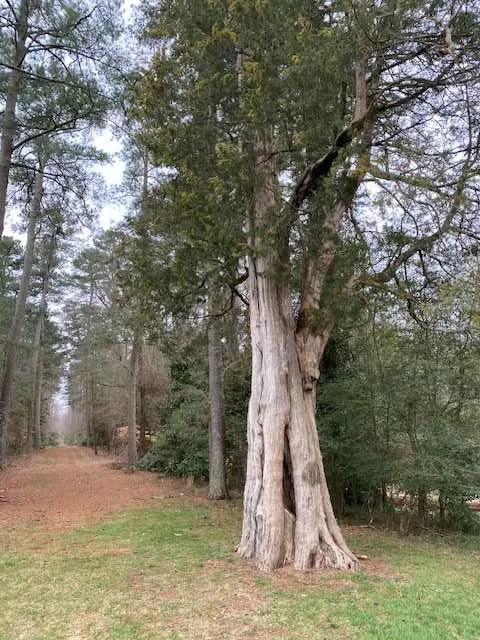
Shurcliff’s Eastern red cedar may be the oldest tree living at Colonial Williamsburg. Photo courtesy of Rick Brown 2023
If fragrance is the gate of memory, the spicy aroma of Eastern red cedar takes me back to childhood holidays. My parents would load us in the car, about a week before Christmas, for a drive out to a friend’s farm where we could walk through the meadows in search of our Christmas tree. After a lively debate about the trees we found, Dad would pull out an old handsaw and begin cutting the tree. We would all help carry the fresh tree back to the car, where Dad and his friend would tie the tree on our roof with pieces of old rope. Then we would say our ‘thanks-yous’ and ‘good-byes’ before happily taking our tree home to soak for a day in a bucket of water before bringing it indoors to decorate.
The lower branches that Dad trimmed away to make the tree fit in our tree stand went on the mantle between candles, or onto the kitchen table around our Advent wreath. Once the tree came home, the house smelled like Christmas once again.
But we enjoyed the fragrance of cedar year-round. Young women in my mother’s era were given a chest made of cedar wood to hold the quilts and linens they were collecting for their future home. The chests were constructed from the fragrant, red ‘heartwood’ that develops in the center of mature cedar trees. Embroidered pillowcases and tablecloths were protected from mice and moths in these sturdy chests. Blankets stacked in Mother’s cedar chest through the summer smelled wonderfully fresh when they came out and onto our beds at the first hint of autumn’s chill. We had small balls of cedar wood in our drawers and slabs hanging among the winter coats in our closets, to protect our clothing from moths.

West side of the cedar allee at the southern end of the Palace Green, between Duke of Gloucester and Francis Streets. Photo courtesy of Rick Brown 2023
Red cedar trees, Juniperus virginiana, grow in such abundance in our area that young trees may be overlooked as weedy or removed in favor of other species. Yet a collection of mature red cedar trees grows around Colonial Williamsburg, demonstrating how beautiful these trees become with age. An allee of red cedar trees was planted flanking the Palace Green during the reconstruction of Colonial Williamsburg in the 1930s. One of the oldest documented trees at Colonial Williamsburg, Shurcliff’s Cedar, is likely more than 250 years old.
These native red cedar trees thrive in the sandy soil of the Outer Banks of North Carolina as easily as they grow here, and also further west in the Appalachian and Blue Ridge Mountains. They grow from Southeastern Canada to the Gulf Coast, and west to Texas, Northern Mexico, and the Great Plains, in Zones 2-9 on most any type of soil, and in any degree of sunlight from full sun to partial shade. They are drought tolerant, but also thrive in riparian wetlands and low-lying areas with wet soil.
There are more than 50 species of Juniperus distributed throughout the Northern Hemisphere. J. scopulorum, or Rocky Mountain red cedar, is another of the thirteen Juniperus species native to North America. It is very similar to Eastern red cedar but grows in the western half of the continent from Canada south to northern Mexico. Red cedar may sometimes be confused with Eastern white cedar or American arborvitae, Thuja occidentalis, both members of the Cupressaceae or Cypress family of evergreens. Eastern white cedar grows into a larger tree than Eastern red cedar, but doesn’t grow as well in full sun and is not as drought tolerant. Deer may browse on white cedar, but leave red cedar alone.
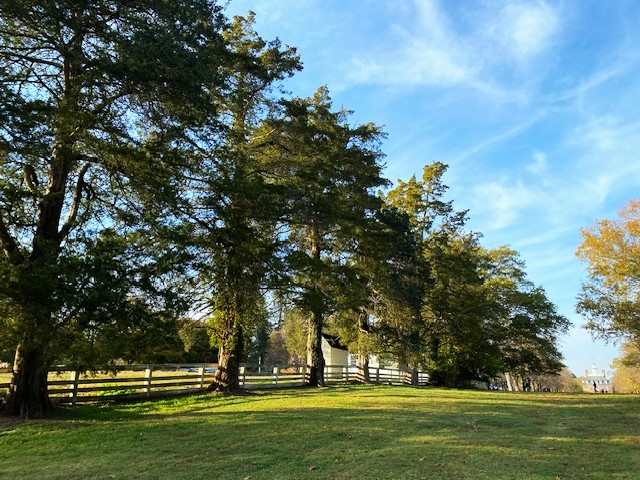
West side of the cedar allee at the southern end of the palace green, between Duke of Gloucester and Francis Streets, taken from eastern side, looking towards the Governor’s Palace. Photo courtesy of Rick Brown 2023
Eastern red cedar is a ‘pioneer species’ which will grow in previously uncultivated, eroded, or damaged land, and will begin the colonization process to return fields and grasslands to forest. It can survive in very thin soil, and will also take root in rocky and mountainous areas where trees have not previously grown.
This very fast-growing species takes up carbon and nitrogen from the air very efficiently, sequestering these elements in their wood and foliage as their leaves emit fresh oxygen and water vapor. These common trees make an excellent windbreak around cultivated fields and help control erosion near waterways with their fine, fibrous root systems. They are also good trees to plant near homes because they are sturdy, long-lived, and are not easily damaged in storms.
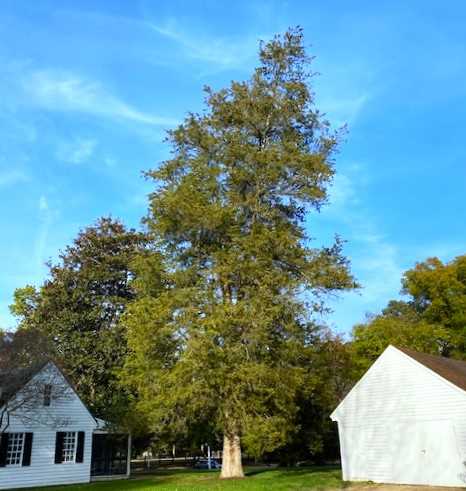
An Eastern red cedar grows beside the caretaker’s cottage at Bassett Hall. Photo courtesy of Rick Brown 2023
Red cedar wood, for which the city of Baton Rouge, LA is named (red stick), is known for its fragrance, its beauty, its durability, and resistance to rot. Native Americans prized this wood for many purposes. They used upright cedar posts to mark boundaries of tribal hunting grounds, for construction, and they burned cedar for its fragrance before ceremonies and during healings. Red cedar wood is prized for making bows, various bowls and containers, and other everyday implements, including pencils. Today it is used to line drawers and closets and for making fine furniture. Fence posts made from red cedar last a long time because they are so resistant to rot.
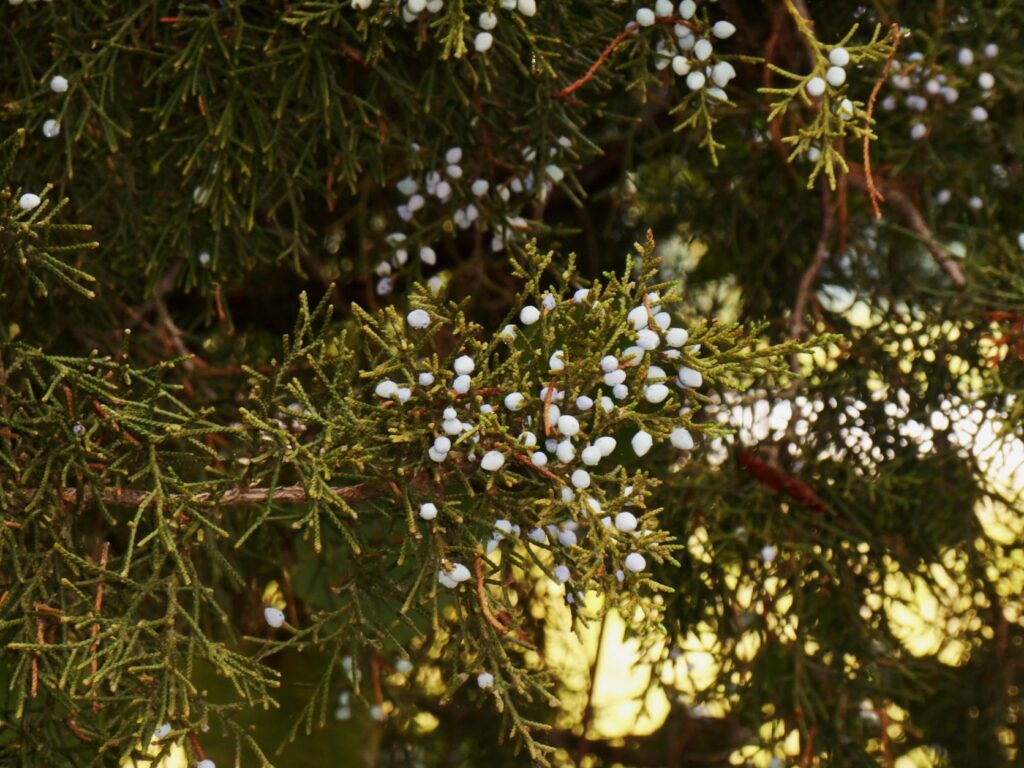
Red cedar, with developing fruits, in early July. Notice the overlapping scales on the foliage. Photo by E. McCoy
Native Americans used the fruits of red cedar to flavor venison, to cook with grains, and to make medicinal tea. The fruits are flavorful and have a variety of medicinal properties. Cedar leaves may also be brewed in tea, and the wood can be used to smoke meat. It is important to be sure of the tree’s identification before ingesting berries or leaves, however, as similar looking berries on other species may be poisonous. Cedar fruits in large quantities are slightly poisonous.
Cedar boughs, harvested in late autumn, can be woven into wreaths and other holiday decorations. They are long lasting and very fragrant, especially when mixed with rosemary, thyme, pine cones, seed pods, rose hips and late season roses.
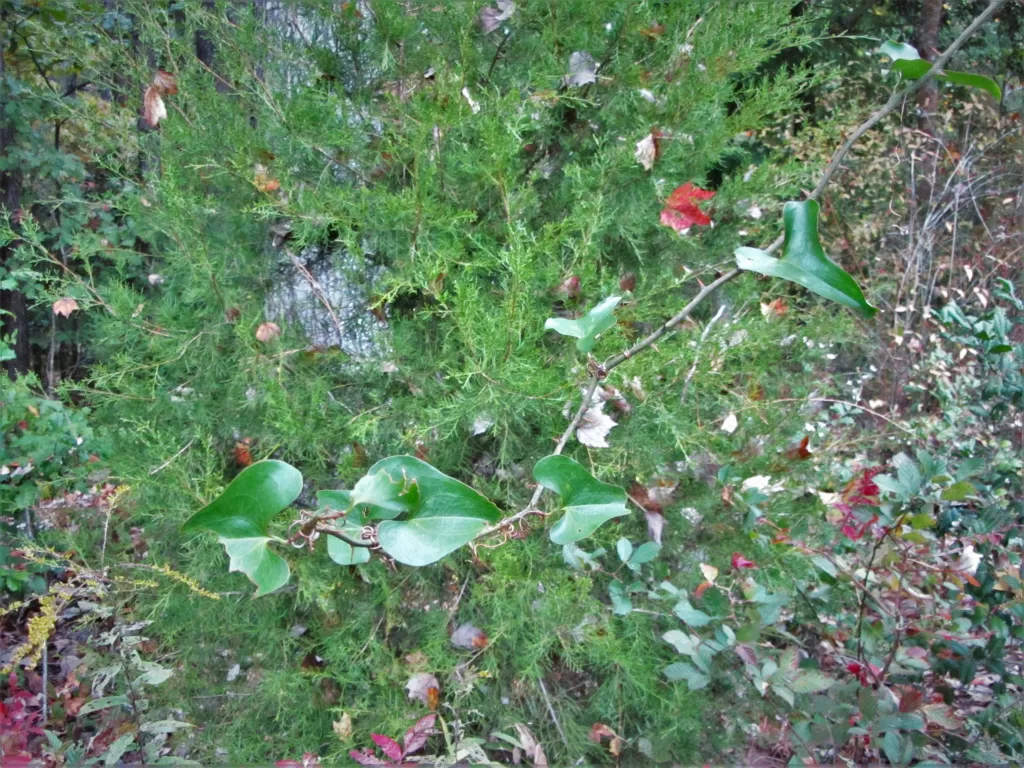
A very young cedar supports a greenbrier vine. Notice how some of the needles look like sharp little awls having not yet reached their mature foliage form. At this stage, the trees may look a bit weedy. Photo by E. McCoy October 2020
The oils within cedar wood and fruits also have many commercial uses. These volatile oils make the wood very flammable, however. A fire made with cedar sticks smells delicious, but care should be taken if red cedar trees grow near one’s home. Dropped needles and branches are particularly flammable.
Red cedar trees are one on the native species in our region which remain green and vibrant during the winter. They are most noticeable when they stand shining in the winter sun alongside other evergreen native trees like pines, hollies, Magnolia, and wax myrtle. Red cedar trees grow to 40’-50’ tall and about 20’ wide. The color of their foliage varies with the seasons, becoming somewhat darker during colder weather and lighter again with new spring growth. Named cultivars are known for their specific shade of green and other growth characteristics, and it is possible to purchase a variety of forms now, including narrow columnar varieties.
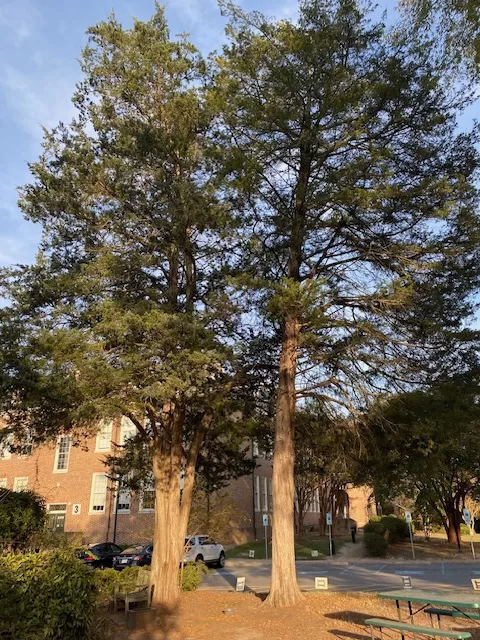
Cedars grow near Mattey’s Garden at Matthew Whaley Elementary School in Williamsburg. A female is on the left, and a male on the right. Photo courtesy of Rick Brown 2023
They provide protected nesting and roosting sites for many birds and other small animals during foul weather and over 54 bird species eat its fruit. The cedar waxwing is particularly fond of red cedar fruits, along with purple finches, robins, evening grosbeaks, warblers, flickers, mockingbirds, bluebirds, bobwhite, swallows, eastern kingbirds, jays, and cardinals. These trees are also a larval host plant for Juniper Hairstreak (Callophrys gryneus) and imperial moth (Eacles imperialis) larvae, and some butterflies visit the female flowers for nectar. Allowing these trees to mature on one’s property, even as part of a hedge or windbreak, increases the variety of wildlife traffic to your yard.
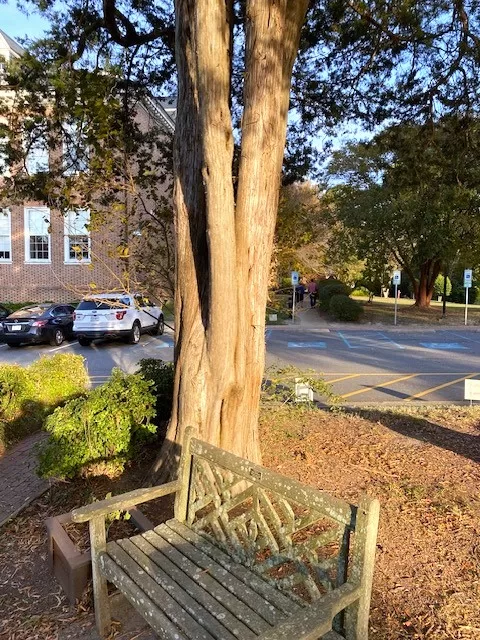
Detail of the exfoliating bark on the trunk of the female eastern red cedar at Mattey’s Garden. Photo courtesy of Rick Brown 2023
Eastern red cedar trees are long-lived, perhaps to 900 years, and the trees’ trunks become fluted as the tree ages. The exfoliating bark is stringy and grey, brown, or red. Trees may be predominantly male, with small yellowish pollen cones, or female, with abundant waxy blue cones (fruits) ripening in September. Trees of both genders bloom from January to March.
Birds who eat the cedar fruits also plant the next crop of trees. Cedar seedlings may be hard to identify because the leaves on young trees are spreading and look like tiny awls or needles. They look different from the scaly, overlapping foliage on a more mature tree. Seedlings may resemble a tiny, skinny pine tree. Both needle forms are evergreen, and both types have their distinctive fragrance.
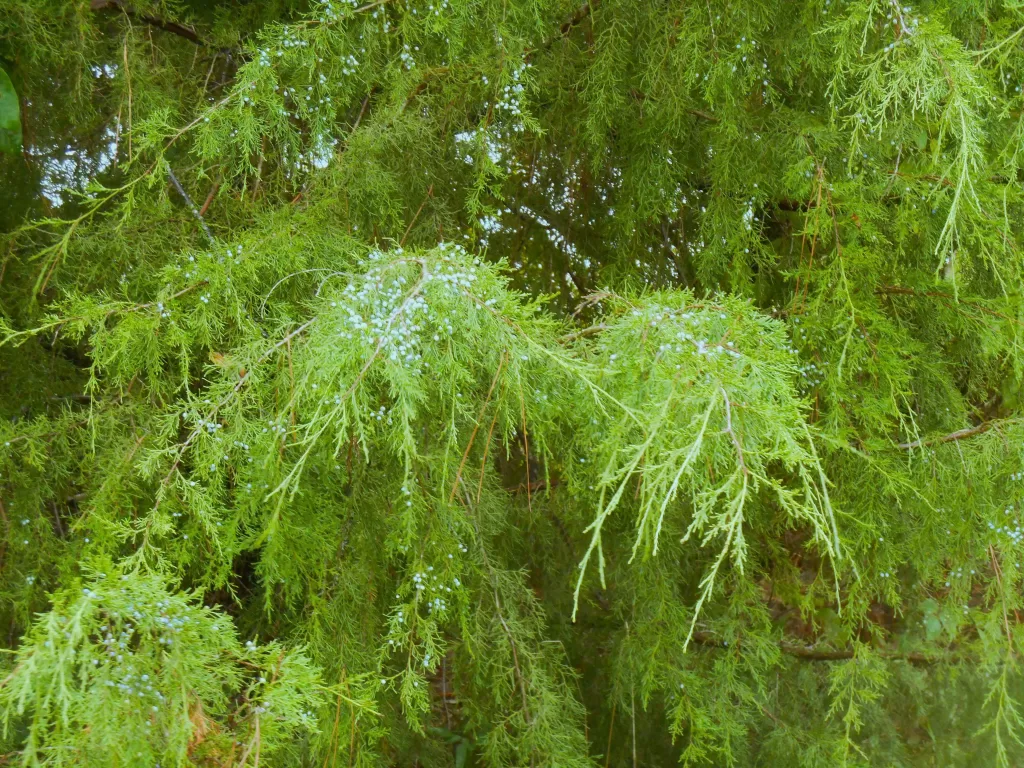
Fruits have ripened in early October, ready to sustain birds throughout the coming winter. Photo by E. McCoy 2015
Most older red cedar trees have been ‘limbed up’ as they age. Removing the lower branches exposes the tree’s beautiful trunk and bark, and helps this large tree fit into the landscape better. More sunlight reaches the area below and around the tree, which is especially important if the tree is growing in a pasture where animals graze or when the tree is growing near walkways and other structures. A red cedar tree’s canopy grows wider and more open as it ages.
It is easy to dig and transplant a seedling tree (from private property and with permission), order young trees from online nurseries, or shop for a specific named cultivar of J. virginiana locally. These common native trees are highly functional in our landscape and reflect the natural beauty of our native landscapes. They also link us to our heritage, and to the indigenous native people who lived here prior to colonization. If fragrance is the gateway of memory, it is also a link to what is timeless in our understanding of the history this beautiful place.

Eastern red cedar grow on the bank of Sandy Bay on the causeway to Jamestown Island. Photo by E. McCoy March 2014
Both Elizabeth McCoy and Rick Brown are Master Gardener Tree Stewards.
Rick is also a volunteer with the Colonial Williamsburg Gardens and Arboretum.
For More Information
Dirr, Michael A. Dirr’s Encyclopedia of Trees and Shrubs. Timber Press. 2011.
Dirr, Michael A and Keith S. Warren. The Tree Book: Superior Selections for Landscapes, Streetscapes, and Gardens. Timber Press. 2019.
Dove, Tony and Ginger Woolridge. Essential Native Trees and Shrubs for the Eastern United States. Bunker Hill Studio Books. 2018
Dutton, Joan Parry. Plants of Colonial Williamsburg – How to Identify 200 of Colonial America’s Flowers, Herbs and Trees. The Colonial Williamsburg Foundation. 1979.
Kershner, Bruce (and others). National Wildlife Federation Field Guide to Trees of North America. Union Square & Company. 2008.
Kirkman, L. Katherine, Claud L. Brown, and Donald J. Leopold. Native Trees of the Southeast. Timber Press. 2007.
Mellichamp, Larry and Will Stuart. Native Plants of the Southeast. Timber Press. 2014.
National Audubon Society. Audubon Society Field Guide to North American Trees: Eastern Region. Knopf. 1980
Sibley, David Allen. The Sibley Guide to Trees. Knopf. 2009.
Wasowski, Sally and Andy Wasowski. Gardening with Native Plants of the South. Taylor Publishing Company. 1994.
Wulf, Andrea. The Brother Gardeners: A Generation of Gentlemen Naturalists and the Birth of an Obsession. Vintage Books. 2010.

